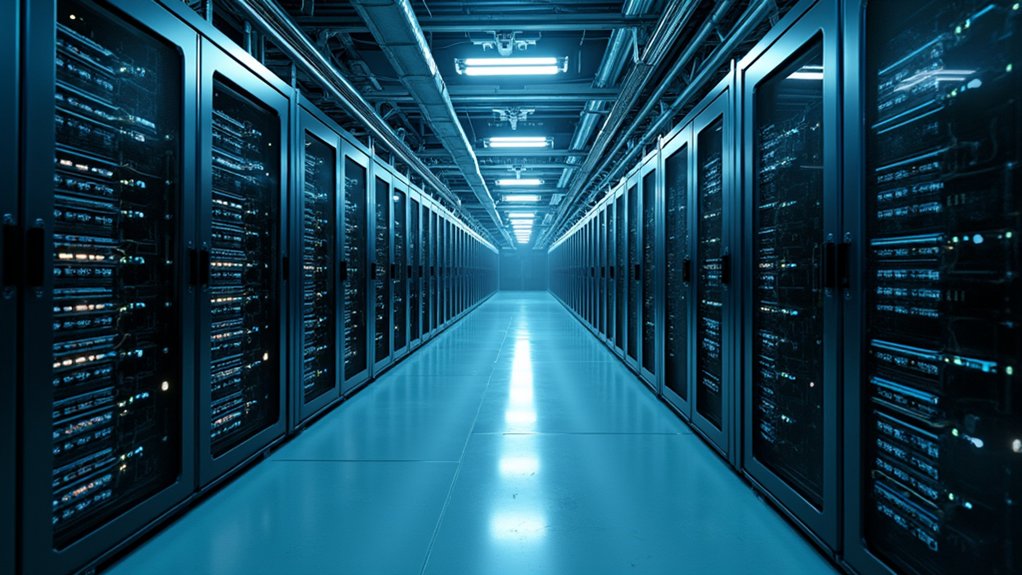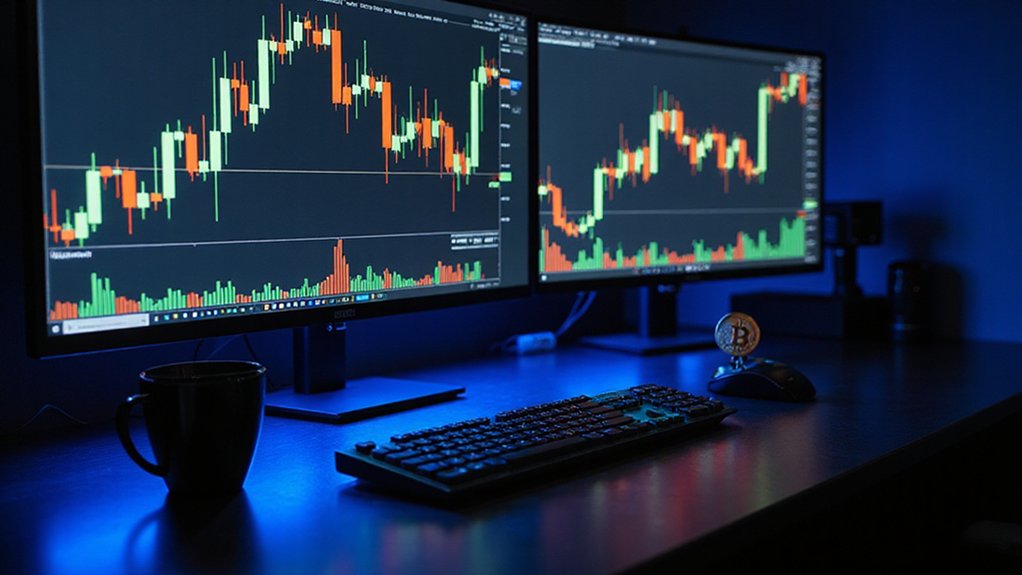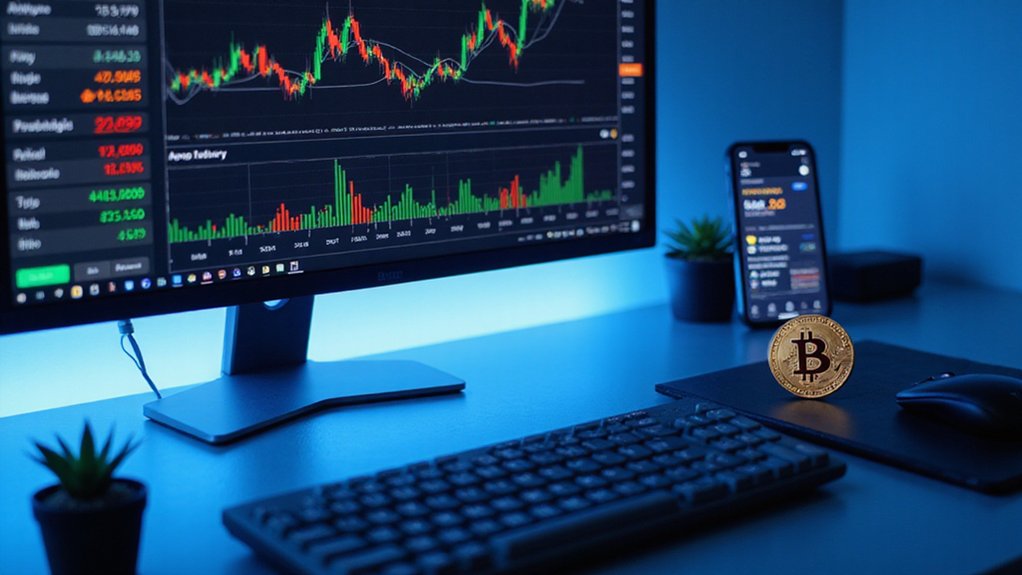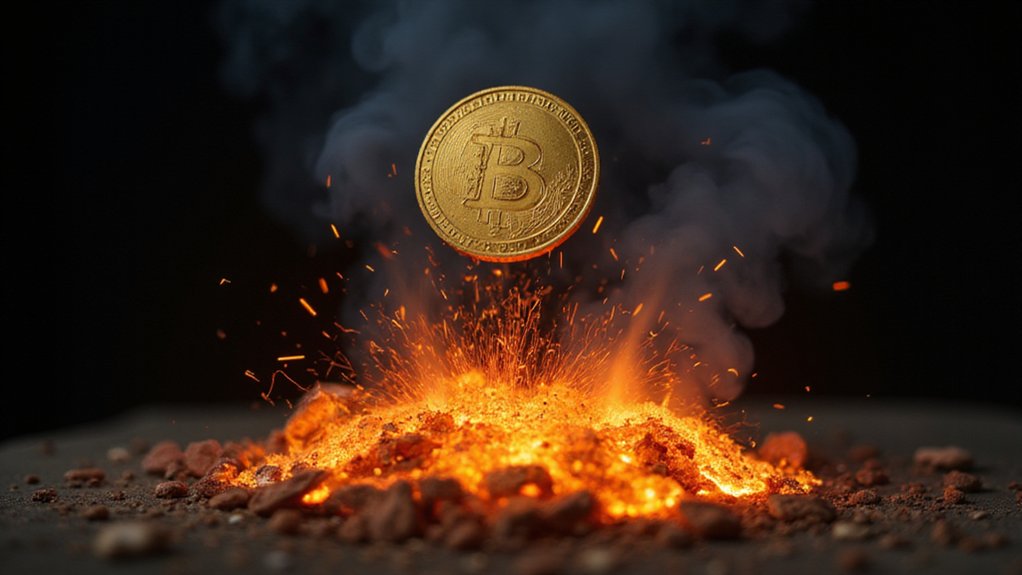Bitcoin mining combines cryptography and computing power to verify blockchain transactions while minting new coins. Miners deploy specialized ASIC hardware to solve complex SHA-256 hash puzzles, basically playing a high-stakes computational lottery where the winner adds the next block to the chain. This resource-intensive process—now far beyond the domain of hobbyists with laptops—requires industrial-scale operations consuming electricity rivaling small nations. The economic incentives, despite their environmental controversy, cleverly secure the network without centralized oversight. The technical details behind this digital gold rush reveal an elegant system of checks and balances.
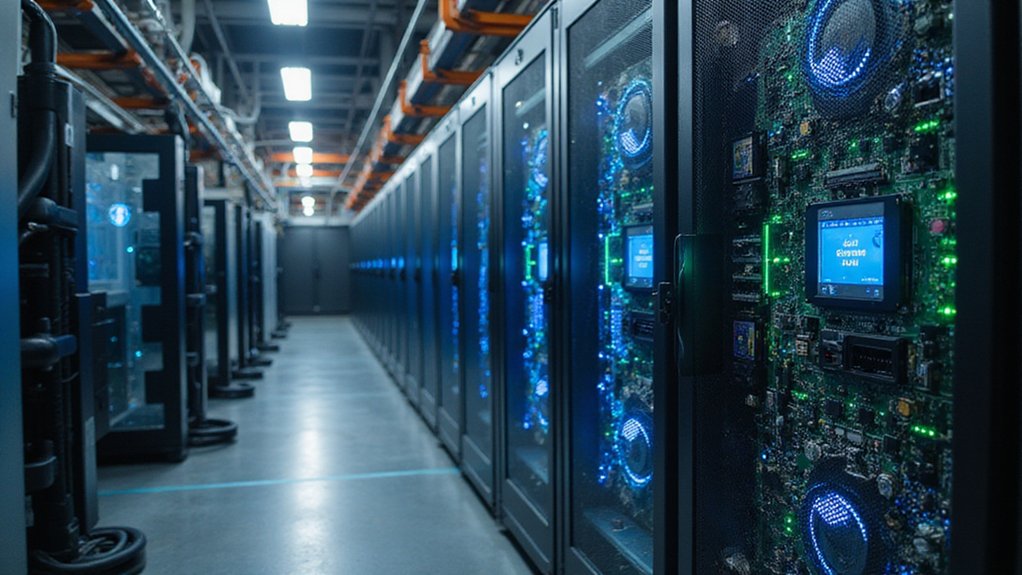
How does an entirely digital currency materialize from the ether of cyberspace? The answer lies in a resource-intensive process called bitcoin mining—a curious fusion of cryptography, computing power, and economic incentives that forms the backbone of the world’s most prominent cryptocurrency.
Bitcoin mining serves as both the verification mechanism for transactions and the minting press for new coins.
Miners—those intrepid digital prospectors—collect pending transactions from the mempool, compiling them into blocks that will eventually join the immutable ledger known as the blockchain.
Each transaction must be vetted, with higher fees typically guaranteeing prioritized processing (capitalism, it seems, functions predictably even in decentralized systems).
The crux of the mining process involves solving fiendishly complex mathematical puzzles using the SHA-256 hashing algorithm.
Miners wage a digital arms race, wielding algorithmic pickaxes against SHA-256’s cryptographic bedrock to unearth mathematical solutions.
Miners harness specialized hardware—primarily Application-Specific Integrated Circuits (ASICs)—to generate millions of hashes per second, searching for a value that satisfies the network’s current difficulty requirement.
This proof-of-work system guarantees the network’s security while conveniently distributing newly minted bitcoins.
When a miner successfully produces a hash lower than the network’s target hash value, they earn the right to add the new block to the blockchain.
The Merkle root calculation combines all transaction hashes in the block into a single hash, ensuring data integrity throughout the verification process.
What began as a hobbyist endeavor executable on standard computers has evolved into an industrial-scale operation.
Modern mining facilities resemble data centers rather than traditional mines, filled with rows of ASICs humming away, generating substantial heat that necessitates sophisticated cooling systems.
The competitive nature of mining—where only the first to solve the puzzle receives the reward—has driven an arms race of computational efficiency.
Many miners choose to join mining pools rather than mine solo, combining their computational resources to increase chances of earning rewards that are then distributed among participants.
This energy-intensive process has drawn criticism for its environmental impact.
The electricity consumed by the Bitcoin network rivals that of small nations¹, prompting questions about sustainability in an increasingly climate-conscious world.
Additionally, miners contend with volatile cryptocurrency prices, regulatory uncertainty, and the ever-increasing difficulty level that adjusts every 2016 blocks.
Despite these challenges, bitcoin mining persists as the critical infrastructure maintaining the network’s integrity.
The miners’ quest for profit inadvertently secures a system designed to operate without centralized control—perhaps one of the more elegant economic incentive structures devised in recent financial history.
¹A fact that advocates argue must be contextualized against the resource consumption of traditional financial systems.
Frequently Asked Questions
What Hardware Is Best for Mining Bitcoin at Home?
For home bitcoin mining, the MicroBT Whatsminer M50S represents the most pragmatic choice—balancing a respectable 126TH/s hash rate with a relatively palatable price point ($2,999).
While the Antminer S21 Hyd boasts superior performance (335TH/s), its cost and cooling requirements render it impractical for residential deployment.
Home miners must navigate the trifecta of spatial constraints, noise tolerance (miners aren’t known for their whisper-quiet operation), and the not-insignificant matter of electricity costs eating into theoretical profits.
How Long Does It Take to Mine One Bitcoin?
Mining one bitcoin isn’t a fixed-duration endeavor—it’s a probability game where time depends entirely on one’s hash power relative to the network total.
For individuals with a single ASIC miner, the timeline stretches into years (if ever).
Most miners join pools where earnings are proportional to contributed computing power.
With current network difficulty post-2024 halving, even commercial operations with multi-petahash capacity require approximately 10 days to mine a single bitcoin—assuming the improbable consistency of both difficulty and luck.
Is Bitcoin Mining Profitable for Individual Miners?
Bitcoin mining profitability for individual miners has become increasingly challenging.
The equation is brutally simple: hardware costs, electricity rates, and mining difficulty versus Bitcoin price—a formula that rarely favors the solo enthusiast.
While compact ASICs like the Avalon Nano 3S offer glimmers of hope, industrial-scale operations with access to cheap electricity have effectively cornered the market.
Individual miners might find more success with alternatives like mining pools, GPU rentals, or pivoting to less competitive altcoins.
How Much Electricity Does Bitcoin Mining Consume?
Bitcoin mining consumes approximately 150 terawatt-hours annually—a staggering 0.6% of global electricity consumption, surpassing the combined usage of 160 countries.
This energy expenditure (which continues to escalate as mining difficulty increases) places Bitcoin’s consumption on par with small nations, with projections suggesting it may rival Australia or the Netherlands by 2025.
Perhaps most sobering: a single Bitcoin transaction requires energy equivalent to hundreds of thousands of Visa transactions—efficiency that would make even the most ardent crypto enthusiasts wince.
Can Bitcoin Mining Damage My Computer Over Time?
Bitcoin mining can indeed inflict significant wear on computing hardware.
The 24/7 operation at maximum processing capacity subjects components to thermal stress, accelerated degradation, and premature failure.
GPUs and ASICs experience particular strain, with cooling systems rapidly accumulating debris while power supplies endure constant electrical loads.
Unlike standard computing tasks, mining’s unrelenting resource demands can substantially reduce hardware lifespan—transforming a perfectly serviceable machine into an expensive paperweight within a fraction of its expected operational window.
